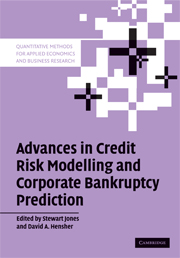Book contents
- Frontmatter
- Contents
- List of figures
- List of tables
- List of contributors
- Introduction
- 1 A statistical model for credit scoring
- 2 Mixed logit and error component models of corporate insolvency and bankruptcy risk
- 3 An evaluation of open- and closed-form distress prediction models: The nested logit and latent class models
- 4 Survival analysis and omitted dividends
- 5 Non-parametric methods for credit risk analysis: Neural networks and recursive partitioning techniques
- 6 Bankruptcy prediction and structural credit risk models
- 7 Default recovery rates and LGD in credit risk modelling and practice: An updated review of the literature and empirical evidence
- 8 Credit derivatives: Current practices and controversies
- 9 Local government distress in Australia: A latent class regression analysis
- 10 A belief-function perspective to credit risk assessments
- Index
- References
6 - Bankruptcy prediction and structural credit risk models
Published online by Cambridge University Press: 11 June 2010
- Frontmatter
- Contents
- List of figures
- List of tables
- List of contributors
- Introduction
- 1 A statistical model for credit scoring
- 2 Mixed logit and error component models of corporate insolvency and bankruptcy risk
- 3 An evaluation of open- and closed-form distress prediction models: The nested logit and latent class models
- 4 Survival analysis and omitted dividends
- 5 Non-parametric methods for credit risk analysis: Neural networks and recursive partitioning techniques
- 6 Bankruptcy prediction and structural credit risk models
- 7 Default recovery rates and LGD in credit risk modelling and practice: An updated review of the literature and empirical evidence
- 8 Credit derivatives: Current practices and controversies
- 9 Local government distress in Australia: A latent class regression analysis
- 10 A belief-function perspective to credit risk assessments
- Index
- References
Summary
Introduction
Default is triggered by a firm's failure to meet its financial obligations. Default probabilities and changes in expected default frequencies affect markets participants, such as investors and lenders, since they assume responsibility for the credit risk of their investments. The lack of a solid economic understanding of the factors that determine bankruptcy makes explanation and prediction of default difficult to assess. However, the accuracy of these predictors is essential for sound risk management and for evaluation of the vulnerability of corporations and institutional lenders. In recognition of this, the new capital adequacy framework (Basel II) envisages a more active role for banks in measuring the default risk of their loan books. The need for reliable measures of default or credit risk is clear to all.
The accounting and finance literature has produced a variety of models attempting to predict or measure default risk. There are two primary types of models that describe default processes in the credit risk literature: structural models and reduced-form models. Structural models use the evolution of a firm's structural variables, such as asset and debt values, to determine the timing of default. Merton's model (1974) is considered the first structural model. In Merton's model, a firm defaults if, at the time of servicing the debt at debt maturity, its assets are below its outstanding debt. A second approach within the structural framework was introduced by Black and Cox (1976). In this approach default occurs when a firm's asset value falls below a certain threshold.
- Type
- Chapter
- Information
- Publisher: Cambridge University PressPrint publication year: 2008
References
- 1
- Cited by



